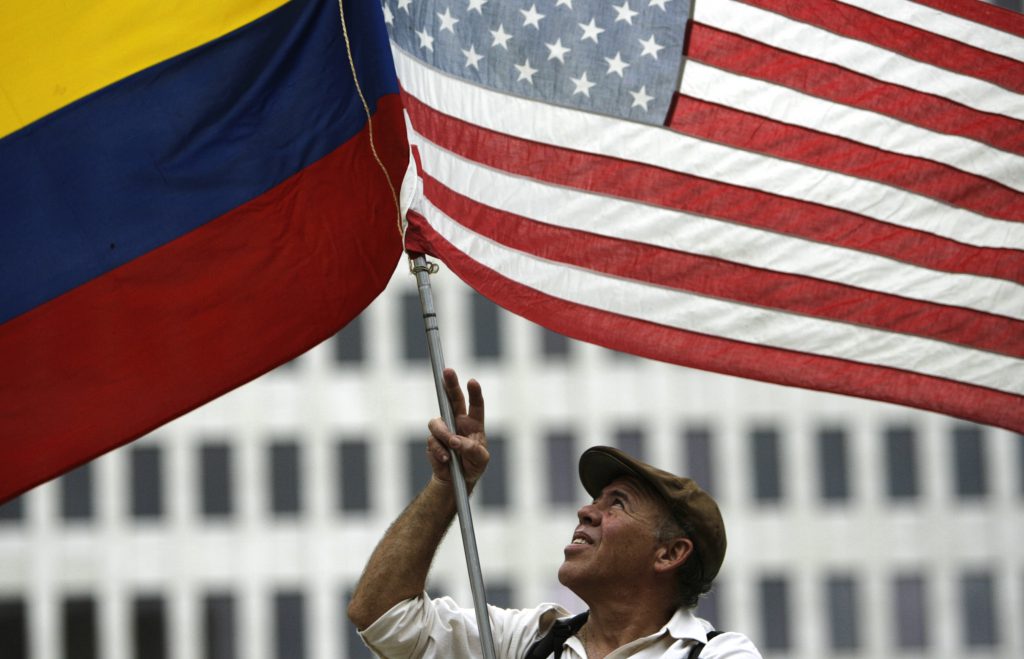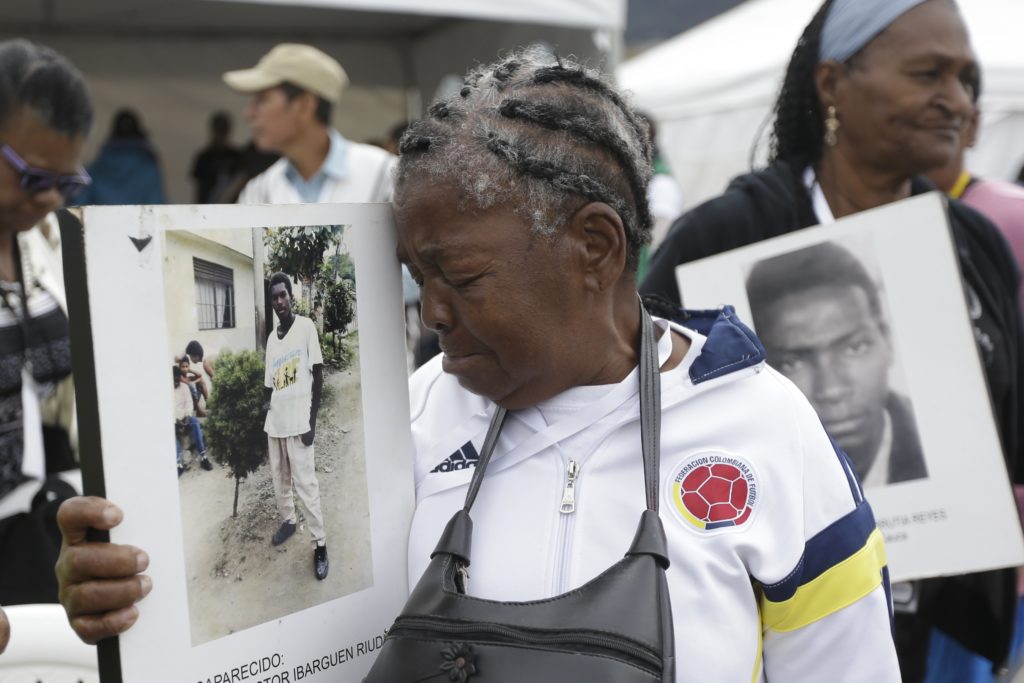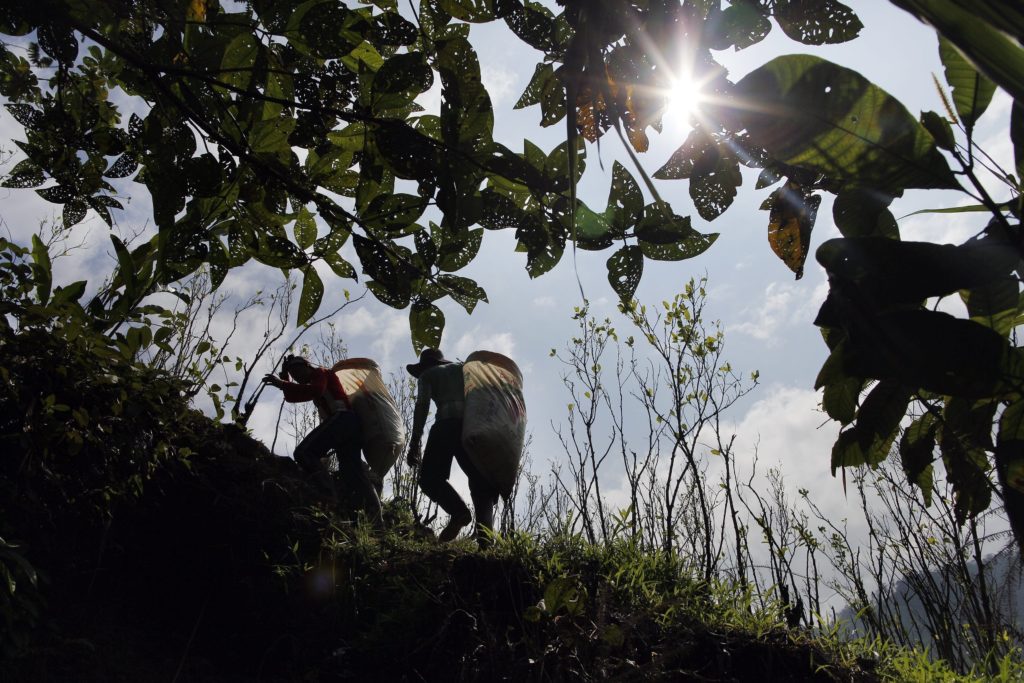(AP Photo/Fernando Vergara)
(AP Photo/Fernando Vergara)
WOLA Director for Defense Oversight Adam Isacson presented the following testimony before the U.S. House of Representatives Tom Lantos Human Rights Commission on July 19, 2018, during a hearing on peace and victims’ rights in Colombia.
There are reasons to feel good about Colombia right now. 6,804 FARC members turned in 8,994 weapons in an orderly, UN-managed process last year. 2017 saw the lowest homicide rate in Colombia since 1975. Landmines have been cleared from 227 counties. The November 2016 peace accord has raised hopes in rural zones for healthy growth in the agricultural economy. “Even among those who are skeptical of the Peace Agreement,” the UN Secretary-General noted in December, “there is a perception that new circumstances have arisen and new opportunities now exist to address historical fractures and build a more stable and unified country.”
That’s the good news. But the bad news is mounting, and it’s ominous.
We’ve heard some very alarming testimony this morning about the present moment in Colombia. Attacks on social leaders continue to escalate, and the government’s efforts have been far from sufficient to arrest the trend.
Implementation of the 2016 peace accord is slipping behind schedule, whether for reintegration of ex-combatants, alternative development in coca-growing zones, establishment of the justice system to try war crimes, or government presence in areas of former FARC influence. We’ve heard concerns about whether the incoming government might break some of the promises that the last government made to victims, and to people hoping to no longer live in conflict zones. And of course we should be alarmed about record levels of coca cultivation.
The concerns we have now are not as severe as the all-out humanitarian emergency of 15 years ago, when Colombia’s armed conflict was at its height. But if today’s trends aren’t arrested, they could be early warning signs of a new catastrophe
We must help Colombia avoid that outcome, at all costs. And we must recognize right now that Colombia’s government can’t shoot or spray its way out of the looming crisis. The way out is more complicated than that. Nonetheless, there’s no need to invent a new roadmap. The 2016 peace accord isn’t a perfect document, but it lays out strong guidelines for what must be done to bring the rule of law into vast ungoverned spaces, and to do right by the conflict’s millions of victims. That, in turn, benefits U.S. interests by making so much more of this very large country inhospitable to drug trafficking and organized crime.

A man waves the Colombian and U.S. flags during an anti-FARC rally in Houston, Texas, on Feb. 4, 2008 (AP Photo/Houston Chronicle, Julio Cortez)
I’m referring especially to parts of the peace accord that have little to do with former FARC members, but that instead seek to benefit Colombians who’ve lived too long without a government, left to coexist with armed groups, organized crime, and warlords.
By helping to implement these provisions of the accord, and by encouraging Colombia to do its utmost, the U.S. government would achieve a happy synergy between Colombia’s struggle for justice and governance, and the U.S. desire for a thriving, stable neighbor that produces far fewer illicit drugs.
In 2017 and 2018, the U.S. government is providing Colombia with about $900 million in assistance, split roughly equally between security or counternarcotics priorities, and economic or peace accord-implementation priorities. As this assistance gets executed, and as Congress considers how to help Colombia stave off the gathering storm clouds and move forward in future years, here are five principles that should guide our actions.
About 77 percent of Colombians live in urban areas today. The larger cities mostly enjoy declining violent crime rates, and barely felt the impact of the conflict during its latter years. It is in rural Colombia—and some cities’ marginal neighborhoods—where government is most absent, where violence continues to be severe, and where the coca and cocaine trades are thriving.
The government and FARC chose 170 counties in Colombia (out of 1,100 total) as priority zones for post-conflict peace accord implementation. Nearly all of them are overwhelmingly rural. Alarmingly, these 170 counties suffered 32 percent more homicides in the first four months of 2018 than they did during the same period in 2017.
Colombia’s rural hotspots have a common characteristic: almost no evidence of government presence. There may be a small primary school here or there, or a health post with a visiting nurse. But roads are so bad that 20 miles per hour is impossibly fast. Small farmers don’t hold titles and can’t get credit through legal channels. Village leaders routinely say they haven’t been visited even by their municipalities’ mayors in years. Nobody passes through to tell coca-growers that they are doing something illegal. In some areas, even national currency is so scarce that people buy goods with bits of coca paste. Entire counties have just one judge or prosecutor, and often not even that.
The peace accord offers a historic opportunity to bring the government, and government services, into these rural zones without having to confront guerrillas first. But this is a brief opportunity. Any vacuum will quickly be filled by new armed groups—and paramilitaries, regional organized crime groups, ELN fighters, and FARC dissidents are doing that right now.
Alarmingly—and this, to me, is the great mystery of the FARC peace process—Colombia’s government has been stunningly slow in filling this vacuum.
A year and a half after the peace accord’s signing, most areas of historic FARC influence have seen precious little evidence of new state presence.
The main efforts so far have been a series of “Territorially Focused Development Plans” in the 170 priority counties, and the signing of about 62,000 agreements with coca-growing families. Neither of these, though, have involved a large deployment of new government personnel, and in neither case has more than an initial trickle of resources begun to flow.
To do this right, Colombia’s government needed a historic effort, a Marshall Plan, to fill the vacuum and start establishing institutions and building infrastructure from the get-go. That hasn’t happened. Post-2016 increases in coca cultivation are a sign that government absence continues.
It is not too late, and hopefully Colombia’s next government will put more political will, personnel, and resources into a plan to bring the state into rural areas. Though the incoming president, Iván Duque, criticizes the peace accord for being soft on the FARC, nothing about bringing the government and services into rural zones is a giveaway to the FARC.
If Duque’s government shows an interest in putting resources into rural governance, it is imperative that the U.S. government accompany it. This will mean, though, resisting the temptation to “govern” rural areas by sending in the military and police. We will know that the Duque government is serious about filling the vacuum if it brings in judges, road-builders, land-titlers, health-care professionals, and other services foreseen in the accords’ first chapter. Any sign of such seriousness deserves generous accompaniment.
During the peace talks with the FARC, government negotiators hailed the accord for “placing victims at the center.” In compliance with a 2011 law, Colombia’s government has registered 8.6 million people—in a country of 50 million—as victims of the armed conflict. A gigantic number of people have been harmed or suffered deep personal loss. Some need reparations or to get stolen land back. Some want to know the truth about what happened to their loved ones. Some simply need the perpetrators to say clearly that their actions were wrong and will never happen again. A definitive end to the conflict means upholding the trampled dignity of 8.6 million people.

Maria Ruidis holds a photo of her missing son Everth Ibarguen, during an event to mark the International Day of the Disappeared, in Bogota, Colombia, Tuesday, Aug. 30, 2016. (AP Photo/Fernando Vergara)
A giant part of that is putting a stop to the horrific ongoing wave of threats and killings of local social leaders, most of whom are among the 8.6 million and are being victimized again. It is in the United States’ strong interest that historically conflictive areas develop their own independent local leaderships, unaligned with armed groups or criminal elements, who can lead efforts to bring the rule of law and guarantee non-repetition of conflict. But too many of these areas have become extremely dangerous places for independent voices. Alarms are going unheeded by a government that is showing the same lack of urgency with which it has approached peace accord implementation.
The U.S. government can help.
So much is relying on Colombian judges, prosecutors, and investigators:
Ten years ago, a massive investigation called “para-politics” uncovered vast webs of relationships between politicians and drug-trafficking paramilitary groups who at the time were responsible for most conflict-related killings. The resulting prosecutions greatly reduced paramilitary groups’ political influence; the lead investigator, Alternate Supreme Court Magistrate Iván Velásquez, now heads the UN’s Commission Against Impunity in Guatemala (CICIG).
Much else, from settling land disputes to guaranteeing U.S. investors’ holdings, depends on Colombia having a well-resourced, well-equipped, well-trained, professional, and physically protected judicial system.
Colombia’s justice system doesn’t require a thorough overhaul—the country’s 1991 constitution strengthened it, and it has been through the crucible of 35 years of anti-cartel efforts—but it still has urgent needs. Corruption remains a huge problem. So do bureaucratization, huge caseloads, security, and a lack of personnel, especially in those crucial rural areas. There is no shortage of opportunities for U.S. assistance to make a difference.
U.S. assistance faces a self-imposed obstacle. The FARC guerrilla group, which is now an unarmed political party, remains on the State Department’s list of foreign terrorist organizations. That may be so for some time: taking a group off of that list is a deliberative process, and requires the FARC to show a sustained record of having abandoned terrorism.
The more short-term problem, though, is that every one of the FARC’s 13,000 former members (including former militias and people released from prison), each of them currently free to circulate around the country, is untouchable for U.S. assistance. Under 18 U.S.C. 2339A, none of these 13,000 individuals may benefit from any U.S. expenditure because it counts as “material support for terrorists.” They are radioactive.
Supporting peace without inadvertently supporting them is becoming very hard to do in practice. If USAID helps Colombia’s government set up a presence in a rural area, it must be on the lookout for one of these 13,000 taking part in a government-run community planning meeting, where he might drink a U.S.-funded cup of coffee or hitch a ride home on a bus or boat rented with U.S. funds. U.S. officials must now prepare to cancel trainings and other events if it turns out that a card-carrying FARC member is participating. Colombian government officials say they find this frustrating.
Obviously top FARC leaders, especially those facing charges of crimes against humanity, should not have their participation in events or programs paid for by the United States. But trying to isolate every rank-and-file former guerrilla is proving untenable.
While the FARC remains unarmed and participating in Colombia’s political process, there must be more common-sense flexibility over implementation of the material-support statute.
If ex-combatant reintegration, crop substitution, and rural government presence are priorities, then we have to recognize that some former low-ranking FARC might get the occasional modest handout. Congress and the State Department must have confidence that U.S. aid professionals and implementing partners know not to support terrorism. While they should be alert to any patterns that ex-guerrillas might be trying to take over a U.S.-funded space, small-scale “material support” should be recognized as unavoidable within a robust program.
The paramount U.S. interest in Colombia should be helping its government and civil society take full advantage of this rare moment: a lull in the conflict offering an opportunity to establish government presence, attend to victims, and strengthen institutions, with a peace accord serving as a roadmap. Doing this is expensive and won’t yield immediate results. But it can prevent the future outbreak of conflict that today’s warning signs portend. It can make unnecessary any huge emergency aid packages like Plan Colombia. And it can set South America’s second-largest country on a path toward modernity and 21st-century competitiveness.

In this Jan. 7, 2016 file photo, laborers take a break for breakfast after picking coca leaves in the mountain region of Antioquia, Colombia. (AP Photo/Rodrigo Abd, File)
Other U.S. interests in Colombia, however, compete for attention. The U.S. government measured a record 209,000 hectares of coca cultivation in 2017, a 160 percent increase over 2013. And Colombia may be hosting well over 1 million people from Venezuela (population 31 million) fleeing their country’s political and economic implosion.
These are important issues, and the U.S. government should help Colombia attend to them. Coca—a symptom of the lack of rural governance discussed in an earlier section—will ultimately be controlled only by the kinds of investments and physical presence foreseen in the peace accord’s first and fourth chapters, as well as an all-out judicial effort to break links between narcotraffickers and government officials. Until Venezuela’s political situation can be resolved—and this seems far off right now, despite intense diplomatic efforts and sanctions—that country’s exodus will require a large humanitarian commitment from the United States and other donor nations.
Attending to these twin challenges must not mean dropping or de-emphasizing the larger goal of seizing the moment the peace process provides. The U.S. government, the Colombian government, and other international partners must “walk and chew gum.” Aid levels will have to stay generous, and Colombia’s engagement will have to remain strong on all fronts.
With new armed groups increasing, social leaders being massacred, and the peace accords’ implementation in doubt, storm clouds are gathering in Colombia. It’s not too late to dissipate them, though. The window of opportunity that the 2016 accords created remains open. Keeping it open won’t be easy—but the alternative is too tragic to contemplate.